Ball Gowns 1940s 1940s Women's Fashion Pictures

Fashion in the 1940s was a proficient mix of comfort and glamour. There were specific outfits that were meant for specific times of the mean solar day. Some of their designs look downright modernistic even by today's standards.
Men were however pretty dressed up. Suits, ties and hats were commonplace in public. Women wore dresses and skirts — they still didn't vesture slacks yet.
Another thing women ALWAYS wore: gloves. Preferably a pair that matches your outfit. Fur was very popular, equally were animate being skins. Crocodile purses, wombat collars, lambskin lining, and leather sleeves — no animal was off limits.
Clothes in the 1940s were very bright and colorful. The brighter the better. Women's shoes were oftentimes i of three popular colour choices: reddish, white or blue.
What did people wear in the 1940s? Accept a deeper await into 1940s style by looking at pictures and reading our yearly timeline below.
QUICK REFERENCE LINKS
1940s Way Timeline
1940 | 1941 | 1942 | 1943 | 1944 | 1945 | 1946 | 1947 | 1948 | 1949
1940s Fashion: In-Depth Profiles
1940s Fashion: Pictures
In-Depth 1940s Fashion Profiles
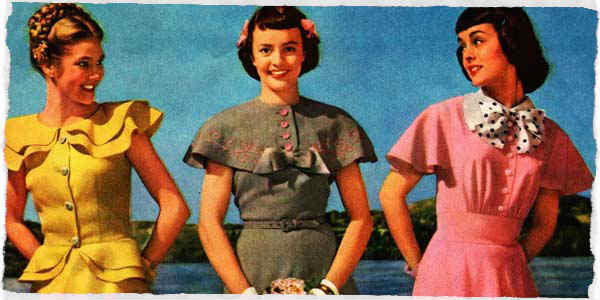
1940s Mode: Women & Girls »
Even though the 1940s fashion industry was bogged down past WWII regulations, that didn't stop designers from making glamorous wearing apparel.
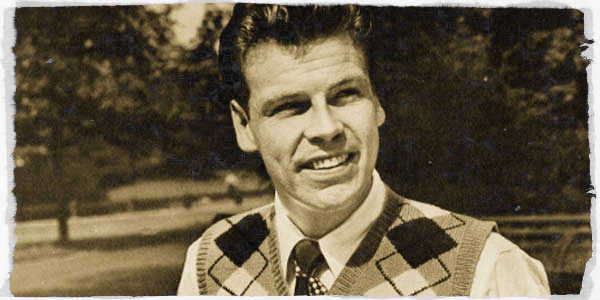
1940s Fashion For Men & Boys »
Military clothing was everywhere in the 1940s. At the office, suits were becoming sleeker, more than thinly cut and more than expensive.
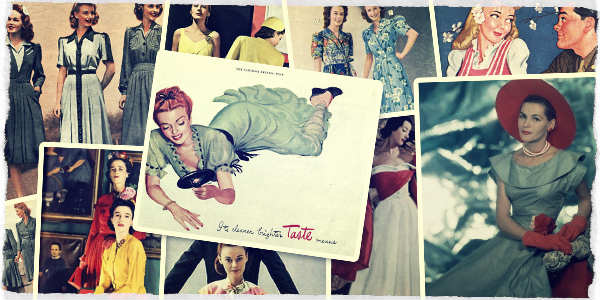
1940s Dresses & Skirts: Styles, Trends & Pictures »
Dresses in the 1940s were fantastic. Mode designers distinguished themselves even further from dressmakers with modern designs and luxurious fabrics.
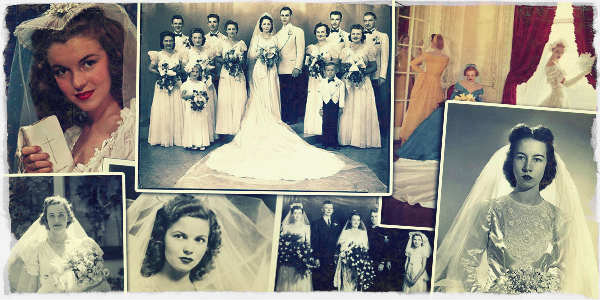
1940s Wedding Dresses & Gowns: Trends & Styles »
Wedding dresses in the 1940s ranged from unproblematic to improvident. Larn about the history of 1940s wedding ceremony gowns and view a picture gallery with over fifty pics.
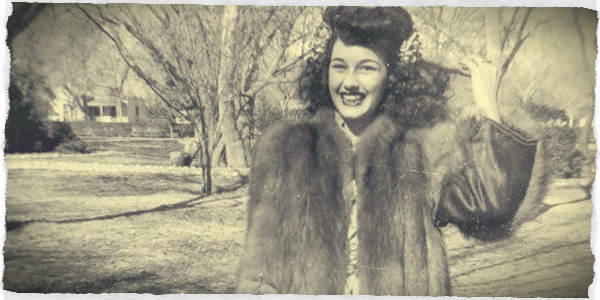
1940s Fur Coats: Trends, Styles & Pictures »
Information technology's impossible to explain the importance of a fur coats in a woman's wardrobe in the 1940s. Simply put, it was the definition of elegance.
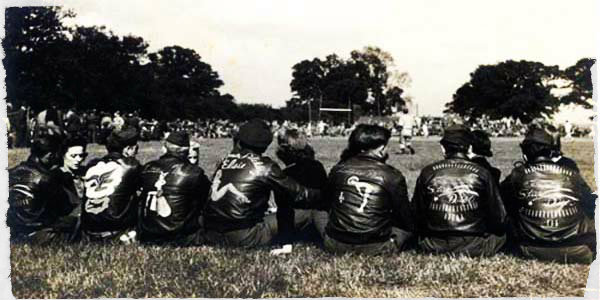
Blazon A-2 Leather Flying Jacket, WWII Bomber Jacket »
The Blazon A-2 leather flight jacket is a armed forces flying jacket typically connected with World War 2 U.S. Ground forces Air Force pilots. It is besides known every bit a bomber jacket.
Fashion in 1941
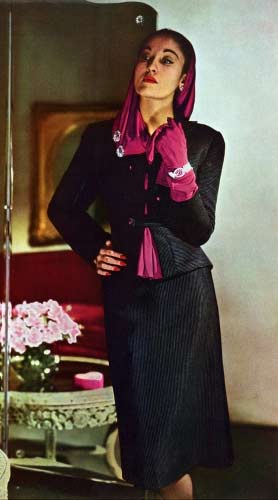
Women's Outfit in 1941 (Harper'south Boutique)
For her easy hours she wanted a really beautiful gown — one that made her feel like Lynn Fontanne. A gown in star sapphire blue, regal or black, with swirls of golden and coral at the deep slashed throat is a perfect example of something a woman would relax in in 1941.
If she breakfasted in bed, she wanted a bed-jacket to match her gown. Or she would habiliment a cozy quilted robe with a matching gown. Nosegay impress in rayon crepe; white or blue with ruby-red ric-rac, maize with green — or pink with bluish.
When she plays cards in the evening she wears a pure cashmere cardigan in maize, grey, blue, natural or purple.
If she likes jewelry she might article of clothing a pin with an exquisite basketweave bowknot in golden plate with rhinestones. She would like earrings with golden swirls with ruby and rhinestone bands. He favorite bracelet is a rhinestone bracelet in a sunburst-and-knot design.
She will also need some Edelweiss doe-pare gloves, a smart umbrella and a handbag — soft one. One that is black suede or claf, gathered on a frame and for extra dash — she'll want her name in gilded script. And for her tweeds, nothing could be better than crocodile skins from the Argentine.
At ease, at home, the man relaxes with his pipe and the newspaper in a chevron-weave smoking jacket. It's made of spun rayon and wool in darker, more subdued colors. At his feet his wore "Freelancers" — bootmaker stop moccasins.
In 1941 they called scarfs "mufflers" and everyone wore ane. They were unremarkably in soft Scotch cashmere with a plaid pattern. Garters were a hot items besides — keeping those broad-ribbed brushed wool socks up.
And speaking of keeping things upwardly, he needed black trimmed rayon moire suspenders complete with monogram.
When he's out he wears a capeskin jacket, or a pure cashmere pullover with coiffure or 5-cervix. Over the sweater he wore a "Huntsman" jacket with Indian Tan soft suede leather and a comfortable bi-swing back.
Back to the lady. When she goes out she wants to wear a love-smooth dinner jacket, with information technology lapels and cuffs encrusted with glittering "jewels."
But what did she smell like? She had all kinds of perfumes to choose from: Charbert'due south Amber, Houbigant's Chantilly, D-Orsay's Le Dandy, Corday'due south Jet, Bourjois' Mais Oui, Suzanne's Tout de Suite and Arden'due south Blue Grass were merely some of the popular perfumes at the time.
Merely if he's in the mood to get really fancy, he would wear an opera hat, white chamois gloves, silk scarf (white and blackness with black fringe or all-white) that's, of course, monogrammed.
How nearly a trip to the big game? It'south gonna exist cold! He needs a waterproofed cotton gabardine coat, lined and collared in lamb. Waterproofed boots with a lining of warm electrified sheepskin.
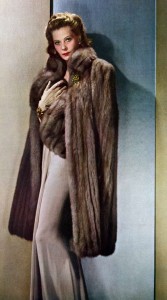
Fur was very popular in 1941
For all-weather clothes, he wants a lightweight raincoat in high-count cotton wool broadcloth, treated with DuPont water repellent Zelan process.
For black necktie nights, he wore a shirt with fastened collar and French cuffs, with gold plated cufflinks, matched to its pique pleated bosom.
An eighteen year-sometime guy thinks his poplin jacket is pretty special. The pure wool alpaca lining zips out and makes a separate sleeveless vest. He also loved his ulster, complete with wombat fur lined collar and the sleeves are leather lined.
An eighteen twelvemonth-sometime daughter loved her effigy cutting outfit with its bright reddish and green plaid skirt and matching stocking cap. And for her trim little sweater in jacquard knit, all pure wool.
The college girl wore a stocking cap fabricated of hand-knit virgin wool with a gyre-neck jerkin. She loved those goofy elbow mittens, to echo her knee-loftier hand-loomed socks. All cable-stitched in fireman red or white.
She wore those frisky boots called "Mounties" for her rustic roadwork and general campus traffic. Complete with a knapsack muff in safari or beaver brownish mouton lamb. With purse space inside, the muff is a perfect spice for her off-campus visit.
Practically required equipment for the gal on the motility was an imported Shetland wool sweater in pink, blue, yellow or white. And she has a HUGE collection of Argyle socks.
Way in 1943
Fashion in 1943 began to prove momentum of its ain, an honest freedom from the great tradition of Paris on which information technology had leaned then heavily, for so long. Clothes were at once less cautious and less tricky. Notwithstanding marked by the simplicity that wartime fabric shortages and the wartime work and psychology of women demanded, the simplicity was tempered by inventiveness of cutting, a genuine suppleness of line.
Ii very distinct silhouettes emerged over the year. One was tubular, slim, reedy, exemplified in straight chemise dresses cinched in at the waist by chugalug, not fit; in knitted dresses that pulled on over the figure like human knee-length sweaters.
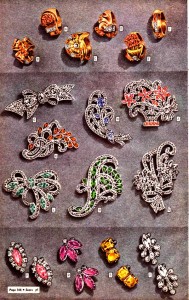
Brooches were a common accessory in 1943
The other silhouette was chunky, bulky, giving the effect of fullness without gathers robust boxcoats in wool or fur, or wool lined in fur; wool dresses cut with the generosity of officers' greatcoats, so decisively belted in.
With either silhouette, the look of the head was decidedly neat and modest, the hair folded upward off the ears and moored on top of the head, netted neatly at the dorsum of the cervix, or twisted in tight neat braids.
Hats fitted close to the skull were hot. Little felt caps, coifs spring tight effectually the hairline, wide bands of textile (chosen "curvettes") worn over the superlative of the head and tied nether the hair in back with strings of felt or velvet ribbon. This curvette was the most pop headpiece (information technology could scarcely be called a lid) of the young. It was seen in every material: felt, fur, crocheted wool flecked with colored sequins for the evening. Many secured their hair in simple snoods of veiling anchored on the head past a band of ribbon.
Suits were however the most popular single manner.
The direct, spare brim was broken across the forepart by soft trouser pleats, and a new hike-back skirt appeared still directly in front, but hiked up slightly in back to get in swing out gracefully behind. The suit jacket grew shorter and niftier.
Three jackets in particular marked a development:
ane.) the short, fitted jacket, nipped in snugly at the waist, slightly flared out over the hipbones;
ii.) the bolero, fitted close to the lines of the figure after the accurate Spanish manner;
3.) the box jacket, extremely young and casual, its squared-off lines accentuating the slimness of the skirt.
Long coats adapted from officers' greatcoats, and brusque coats adapted from seamen'southward jackets, were seen everywhere practical, dashing, adaptable; but information technology was the fur-lined coat, launched in the autumn, that became the big news of winter. Unproblematic tweed reefers, loose box coats, slim mid-length tuxedo coats all wore fur linings.
Even the raincoat made a welcome fur-lined appearance, giving women an opportunity to be warm in whatsoever weather.
The younger generation made almost a uniform of the pinafore or jumper clothes, perfect in cottons for summer; and in greyness flannel, checked tweed, or brilliant wool jersey a wonderful campus costume worn with whatsoever of many shirts and blouses.
A few of the more daring began to couple the pinafore with an accommodation of the ballet dancer's leotard: waist-length tights and a separate crew-cervix shirt of striped or figured wool jersey. This basic outfit dispensed with stockings and near underclothing, and over information technology a pinafore or uncomplicated wrap-on brim completed a whole costume.
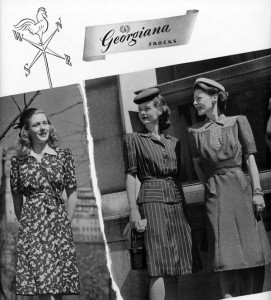
Georgiana Frocks (1943)
Later on several years of covered-upwardly necklines for both day and evening, decolletage came back in fashion. It was get-go seen during the summer in gingham embankment dresses with shoulder-strap tops, and in printed silk town dresses with matching jackets to cover their backless, sleeveless nakedness on the street.
Past winter, 1943, the covered-upward, short-skirted dinner dress of 1942 had become a total-fledged, decollete evening dress: short black slipper satin dresses with ribbons of satin over bare shoulders; halter tops of white satin and sequins barbarically strapping naked backs above unproblematic brusk blackness crepe skirts; brusk blackness crepe dresses with deep oval decolletage and tiny cap sleeves dangerously edged in black lace.
The deep oval decolletage with its little cap sleeves proved then becoming to and then many women, and such a relief from high-neck, long-sleeve fashions that it spread to apparel of every description.
Both the oval and the halter neckline were uppermost also in a new genre of play dress for the south. A casual, feminine type of dress, made in coarse colorful cottons from Mexico and Republic of guatemala, that threatened to supervene upon the shirtwaist wearing apparel, to banish the ubiquitous slacks from the embankment forever.
Fashion in 1945
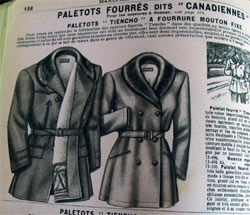
The Canadienne
U.South. fashion designers displayed remarkable creativity when using the limited amount of textiles allotted to them past the government. The rounded line replaced angles, which was the primary means of fugitive boring designs.
At the outset of 1945, the roundness was first achieved by pulling the waist tight, emphasizing fullness above and below the waistline. Somewhen the round look took every costume. Frequently the just tight parts of an outfits were at the neck, waist and wrists.
Suit jackets had round collars and round-cut hemlines, while conform skirts belled out in forepart. The Canadienne, a French twist on the coat of a Canadian soldier, was one of the year's biggest way hits.
Evening dresses often came with farthingales to brand hips seem larger and the waist thinner.
The cholo was hugely pop on beaches in 1945. It was worn over summit of the swimsuit.
The trend of wearing "separates" continued to grow. Shirts were ready to article of clothing, came in a broad diverseness of styles and mixed well with skirts.
A few horseblanket skirts appeared amid the younger crowd. These unique skirts were made of plaid wool horseblankets, bound with black braid and attached with horseblanket buckles.
Gold neckbands, African-inspired metallic rings and gold chains were wrapped effectually the neck and wrists.Buttons were brassy and belt buckles shined like a cowboy's saddle.
Due to the absolute necessity of belts in the wardrobe, manufactures began producing more inventive belt styles than had fifty-fifty been seen before. Some were wide glassy bands of leather and others were cutting to fit the waistline.
Women were especially fond of ballet slippers in 1945. They came in all colors: plaid, blackness, pink — you name information technology — and were worn with everything from skirts to dresses to dancing tights.
Information technology's hard to deny that as 1945 progressed, the mode world took on a much more relaxed and peaceful tone. Like a huge sigh of relief. Colors lightened and fancy fabrics slowly came dorsum. European designers didn't have the worry of a war in their backyard and, with the terminate of World War II, people felt like it was OK to care about something every bit trivial every bit fashion once more. It certainly had been a while.
Mode in 1946
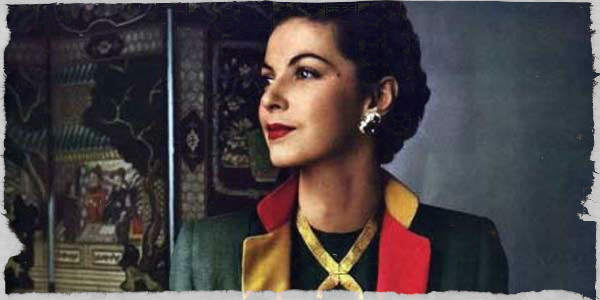
Femininity was in total swing in 1946, Afterward long, wartorn years of wearing suits, women turned to dresses again.
The curves that were so popular in 1945 were replaced by a more natural look. The shoulders and bust were much more than exposed this year, but never in a flamboyant style.
Fifty-fifty though Paris was short on simply about everything only talent, designers did their best to go on their position every bit the way capital of the world.
An asymmetrical look was of import in 1946. Long evening skirts swayed to i side. Dinner dresses appeared with just one shoulder strap. Information technology was a very flattering wait to the female figure.
Two popular suits, the cutaway adjust and the bellhop suit, were very successful for designers. While not overly feminine, they yet had a distinct look from human being-tailored suits, and were exactly what women were looking for.
The Kiltie, a short pleated skirt which came in varied lengths, was a vital part of the playtime wardrobe.
With the end of the war, designers were finally able to dip into their assortment of beautiful fabrics again. Fine Irish linens returned and were used for unproblematic things like mean solar day dresses, or for improvident lace.
Embroidery was seen in about every form: passementerie, jet beading, silk tassels, brawl-fringe and more. Colors were fragile, pale blues and pinks, pale yellows and violet, were common color combinations.
Hats were trimmed with fantastic feathers. The tricorne, bicorne and tiny pillbox were popular lid shapes.
The ankle-length evening dress eclipsed the picture-skirted ball gowns in importance. Shoulders were covered past tiny boleros. Flowing capes draped over day dresses and evening gowns alike. 1 extravagant wrap was a cape cut similar a greatcoat, lined with seal.
The feminine await was certainly aided by the fact that women could buy nylon stockings again. Also, with the rising of the hemline came a new focus on shoes.
Shoes were designed with grace. Gentle arches, high heels and talocrural joint straps all gave the foot a renewed appeal.
Way in 1948
The new expect, which had blossomed, billowed and exploded the indicate of well-nigh absurdity, finally collapsed. Clothes were pared down to create a tight plumbing fixtures, spare expect. It was the total opposite of what had been worn for the last 3 years.
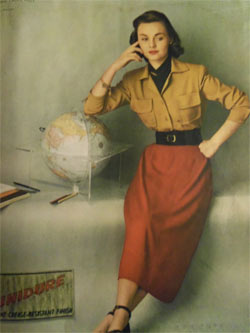 Jackets were short and rib-tight. Skirts were straight in the front and sides, with all fullness drawn to the back. The tent coat disappeared, replaced by the belted greatcoat or the fitted coat with small shoulder capes.
Jackets were short and rib-tight. Skirts were straight in the front and sides, with all fullness drawn to the back. The tent coat disappeared, replaced by the belted greatcoat or the fitted coat with small shoulder capes.
Women who couldn't afford to buy an entirely new wardrobe would pull their loose plumbing equipment wear tighter or just cut them smaller.
The Chugalug of the Year in 1948 was the dog ternion, a thin, rounded and made in a variety of colors and materials. Handbags shrank in size and the extravagant jewelry that had been then popular over the past few years was toned down to smaller pieces.
Gloves were wrist length, scarves were short and fifty-fifty the hats were small.
Oliver Twist waistcoats suddenly appeared in every fabric and color imaginable, but especially of suede and velvet. Stoles became pop once again, made of tweed, wool, jersey, and fur.
A renewed focus on the "going away look" placed more importance on the dorsum. Every bit such, 1948 fashions are markedly more than embellished in the dorsum than 1947 designs.
The lampshade dress was perfected in 1948. The lampshade dress fit very tightly from shoulder to mid-thigh, where it flared out intensely. It was intended for late afternoon and evening wear.
Patent leather fabricated a comeback in 1948 as well, specially in bags and belts.
Fashion in 1949
Jump of 1949 went down in way history as the flight panel period. In the previous fall Balenciaga had shown a fitted suit with narrow skirt, and a wide divide back panel. This original method of achieving a slim await combined with becoming movement fabricated such an impression that the Paris spring collections were full of developments of this flying panel theme.
There were side panels, back and front panels, all-round strip panels like maypole ribbons. Sometimes a three-step hem level was given by panels both longer and shorter than the brim. The skirt itself was always skin-tight.
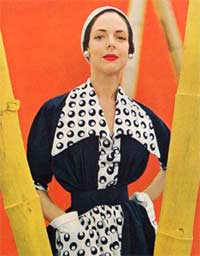
Rayon Wearing apparel in 1949
Another fashion detail which grew to such proportions as to touch on the silhouette was the pocket. Breast-high pockets, funnel-shaped, had flaps pointed and stiffened like calla lily petals to stand upward above shoulder level. In some evening dresses the unabridged bodice consisted of twin pockets. Pouch pockets and huge flap pockets, placed far to the side, widened
the hips.
The spring and summer too saw a new depression level in daytime necklines. Even unproblematic 24-hour interval dresses had necklines which plunged narrowly most to the waist. Tardily-day dresses were apt to have immensely broad deep necklines.
Coats grew collars which rose loftier at the back, then turned down in a sloping line to go miniature capes. There were some fitted, bong-skirted coats, but the pyramid coat, sloping out from cervix to hem, was the prevailing line.
Urchin hair cutting and petulant earrings a distinctive style style in 1949.
Christian Dior showed the first short-and-long evening dress, spiraling from above the knee to train length. This 1949 fashion trend is shown by a sheath evening clothes in blackness wool, slit above knee at back and with grosgrain panels trailing to the ground and the three-footstep hem levels caused by varied length panels were the forerunners of a whole ingather of uneven hems in the autumn collections.
The later the hour, the more skirt lengths wavered. By day the general level had risen once again to 14 or 15 inches from the ground, sometimes ascent farther at a wrap-around bespeak, or slit for walking liberty. Tardily-day and evening brim lengths; nevertheless, were extremely erratic.
The floor-length crinoline skirts, were kept for debutante and ball dresses. A new evening dress line was widely draped at the hips, narrowed to the talocrural joint and then considerably slit.
Newest of all for Europe (but already familiar to America) were the strapless evening dresses in rich fabrics with street-length skirts: a few full, but the bulk slim sheaths the 1920'south all once again, except that these dresses were invariably belted, in contrast to the unbroken line of that earlier period.
Dior's ultra-short sheath, with a huge hip-swathe trailing the floor, was the most dramatic of a whole range of models which achieved short-and-long hemlines by panels, wrap-effectually swathing or slanting overskirts.
Kerchief-pointed skirts, wavering between knee and ballet length, were another aspect of hem-line doubtfulness and another reminder of the '20s also recalled past the ever receding length of pilus.
The short hair of tardily 1948 was still long enough to curlicue out like a drake'due south tail at the nape just belatedly 1949 saw really shingled heads and that variant, the gamine hair cutting, reputedly begun by mannequins fretting their short hair unevenly with razor blades simply soon developed through more orthodox means by the hairdressers.
Of course, this short hair went forth with head-clasping hats. Most of these were small skull-caps, called "beanies," cloches, berets, miniature toques and helmets. There were withal, a few large hats, nonetheless with nothing at the back to impede the high collars but with broad side-to-side brims or jutting shovel brims heralding, perhaps, a frontward movement in hats to come.
The concluding months of 1949 saw the beginning of several important trends. One was again due to Dior: a dropped, markedly extended shoulder line the start sign of an important shoulder treatment since the removal of square padding left shoulders naturally rounded.
These new shoulders were still sloped and unpadded just half-mode between shoulder and elbow Dior attached a gathered flounce, often buttoned, sometimes lined with fur, so that it stood out.
Some other tendency was the molded body-line, interrupted by precipitous-angled shapes in collars, cuffs and stiffened hip draperies. This contrast of soft and sharp was achieved by using soft fabrics and stiffening them with a crisp lining at strategic
points.
Skirts in general narrowed as the year went on.
There was a marked tendency towards asymmetry in clothes of all types. Ane rever would exist longer than the other; a peplum would jump from the hip at ane side merely; a line of buttons (and buttons were everywhere) would march down one side of a bodice or skirt; necklines were cut to one side; evening dresses had one shoulder strap.
Colors connected dark or neutral. A whole range of "charcoal" colors as if black had been mixed with them, appeared. In that location was much beige and grayness. Blueish, petrol and thunder blueish and imperial bluish, returned, specially with black.
Navy blueish was chosen for winter and for evening, and other colors particularly favored were dark greens, many browns and clear geranium reds.
Long gloves went out to meet the three-quarter and elbow-length sleeves. In the evening they rose to shoulder level; were smartest in black glace child. Leather belts pulled in every waist on suits, day dresses, evening dresses. Courtroom shoes and naked sandals (with covered toes and heels) divided the honors.
Colored shoes were seen in shades of ivy foliage green, pewter, blonde, bronze and night red. Yards of pearls circled necks and dropped into deep necklines. Huge chandelier earrings swung to the shoulders piquant contrast to the ragged gamine hair cut.
Nylon lingerie appeared in sufficient quantities to exist on display instead of only nether the counter. Corsets in deep blue and other unconventional colors were a welcome proof that better supplies were making fashion experiments possible.
Realistically to meet their customers' shrinking budgets a number of couture houses in Paris and London launched or expanded boutiques, lilliputian shops selling accessories and more moderately priced unproblematic clothes, ready-to-wear, or needing simply one fitting.
Men'southward Fashions
In the men's fashion field, 1949 saw the expiry of the exaggerated drape jacket, which hung loosely from the shoulders with hardly any indentation at the waist-line. "Drape" was a style which originated in England at the end of the 19th century and gave an illusion of broader shoulders and deeper chest.
Subsequently World War Ii information technology returned to England from America in such exaggerated forms that the style leaders at last decided that it no longer had a identify in men'due south fashions.
1940s Fashion Pictures
CLICK IMAGE TO Overstate
0 Response to "Ball Gowns 1940s 1940s Women's Fashion Pictures"
Post a Comment